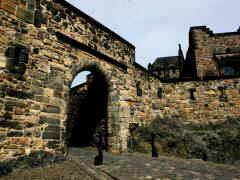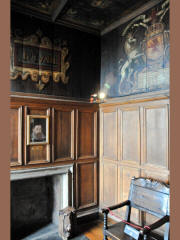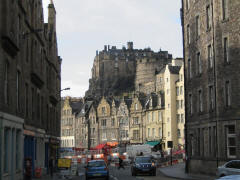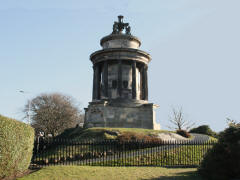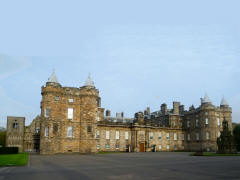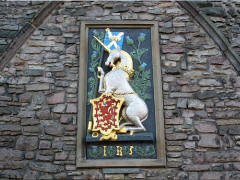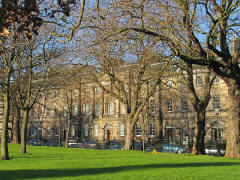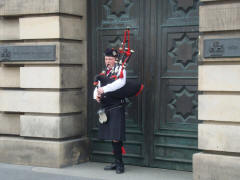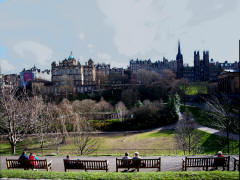|
SCOTLAND Friday, 14 September. We were up
by 6:00 and had
breakfast in our room. We were taking a 9 1/2 hour bus tour
to Edinburgh that left a 7:45. The 70-mile drive took
about 90 minutes. We took the expressway west along the
Clyde River Estuary through the city of Grenock. We
crossed the Clyde near Glasgow and passed through the
northern part of that city, but there wasn't much to see
from the bus. The highway was congested until we cleared
Glasgow; then it was smooth sailing. We entered the
Edinburgh city limits about 9:00, but it was another 45
minutes before we were at the Castle. The weather was
cool and very windy. It was mostly cloudy, but the sun
would come out from time to time.
A fortress perched atop an extinct volcano, the Castle dominates the city skyline. There has been a royal castle here since at least the 12th century. Unfortunately, the Castle did not present a pretty picture at its entrance. Much of the esplanade was covered by the huge, ugly metal grandstand, built to seat the large crowds that attend the Royal Edinburgh Military Tattoo each August. Our group entered through the Portcullis Gate and, after some preliminary information from our guide below the Half Moon Battery, we started up the steep walk past the military barracks. The battlements were lined with cannon, but most of them were ship cannon (on wheels) and had no historical or logical connection to the Castle. We passed through Foog's Gate and walked up to Crown
Square, the heart of the Castle. The Square is formed by
the Royal Palace (15th century) to the east, the Great
Hall (about 1511) to the south, the Queen Anne Building
to the west, and the National War Memorial to the north.
After a brief orientation, our guide gave us an hour to explore on our own.
We visited the Royal Palace first. but because of the line waiting to see the Crown Jewels,
we went through the Royal Apartments there first. The
Apartments were the residence of the Stewart monarchs
beginning in the mid-1400s. In addition to the usual
grand rooms, we saw the small Birth Chamber where in
1566 Mary Queen of Scots gave birth to her only child,
James. James became King James VI of Scotland the
following year when Mary was forced to abdicate. Mary
fled to England but was imprisoned by Queen Elizabeth I
and eventually executed (1587). Her son became King
James I of England in 1603. He was a patron of William
Shakespeare as well as the sponsor of a new translation
of the Bible, the well known King James version.When we emerged from the Royal Apartments, there still was a line to see the Crown Jewels so we visited the Great Hall next. The Great Hall was the site of state ceremonies, banquets, and all other large assemblies in the Castle. It was later used as a barracks, then a hospital before being restored in the 1880s.
We skipped the Queen Anne Building (1708). It once provided accommodation for staff officers, later was a Naval and Military Museum, and now houses other Castle functions. Instead we visited the National War Memorial, opened in 1927 as a tribute to Scots killed in World War I, but later broadened to include those who died in subsequent conflicts as well. It's housed in a former barracks (1755). By the time we left the Museum, the line to see the Crown Jewels was very short, so we went back to the Royal Palace, The Crown Jewels, also called the Honors of Scotland, consist of the Crown, the Scepter, and the Sword of State.. They date from the 15th and 16th centuries, making them the oldest set of crown jewels in the British Isles. Next we made our way up to the top of Castle Rock, the highest point in the Castle. This is the site of the tiny St. Margaret's Chapel, the oldest surviving building in Edinburgh (c. 1150). It was spared when the Castle was captured in 1314 and all its other buildings were destroyed. There were great views from the ramparts in the chapel area, both of Edinburgh and into the Castle below, including the Castle's dog cemetery.
Just next to the Chapel was Mons Meg (1449). This huge cannon is one of Europe's oldest surviving medieval bombards. It has a 20 inch bore and could fire a 400 pound ball almost two miles. However, since this was a siege gun, designed for attacking castles rather than defending them, it seems doubtful that it was ever part of the armaments at Edinburgh Castle. We started down toward the Castle gate where we were supposed to meet our group at 11:00. We had a few minutes left, though, so we stopped to go through the Royal Scots Dragoon Guards Regimental Museum on the way down. Since no traffic is allowed on most of the Royal Mile, our bus took us down Princes Street, which runs parallel. We got a reminder of Scotland's great literary tradition as we passed the Walter Scott Monument and, a little later, the Robert Burns Memorial. (Other names that come readily to mind include Robert Louis Stevenson and Arthur Conan Doyle.) We soon arrived at Holyrood Palace (or Holyroodhouse), the official royal residence in Scotland. The Palace sits at the foot of the Royal Mile and on the edge of hilly Holyrood Park. The Palace is used for state ceremonies and official entertaining. The ruins of an Augustinian Abbey (1128) share the grounds.
Just across from Holyrood Palace was the controversial new Parliament complex (2004), a group of many buildings of various architectural styles. It was built largely with imported materials (Chinese granite!!) and cost ten times the original estimates. Just behind the Parliament, we could see Calton Hill with the Admiral Nelson Monument (1816) and the Acropolis (1822), an unfinished replica of the Parthenon. The bus then took us up into the hills of Holyrood Park. Because the city is mostly flat toward the Royal Mile, there was a great view of the old city. Arthur's Seat is the highest spot (822 feet) in the park, but I'm not sure that was where we were. Then, whether by design or because of traffic requirements, we had a bus tour of much of the Old Town. We drove along Cowgate through the area once known as Little Ireland. We went by the National Museum, got onto a short stretch of the lower end of the Royal Mile that was open to traffic, somehow got back on Princes Street and then zigzagged through the area known as New Town (although it dates back to 1766). It has many Georgian-style buildings, especially in the neighborhoods around its two main parks, Charlotte Square and St. Andrew Square. We saw many old buildings with row after row of chimneys, each with nearly 20 flues. About 1:00 the bus wound around to a restaurant just off High Street where we had a big lunch. Then at 2:00 we were turned loose for an hour to explore on our own. Jane and I walked down to Waterloo Square, marked by an equestrian statue of the Duke of Wellington in front on the National Archives, and across from the ornate Balmoral Hotel (1902). Then we walked down Princes Street to see the Scott Monument up close. We continued on to Princes Garden. This lovely park was once a loch (lake). It was drained and filled with materials from the excavations of New Town. The park provides a great view of the skyline of the buildings just above. Among them were the Bank of Scotland (1806) and the New College (1846) of the University of Edinburgh.
We wanted to use our little remaining time to walk down the Royal Mile. To get there, we had to climb The Mound , a hill also created with materials from the excavations of New Town. The road looped around the National Gallery of Scotland before topping The Mound. We got onto High Street (part of the Royal Mile) near St. Giles Cathedral (late 14th century), the principal place of worship of the Church of Scotland (Presbyterian). Of course, when we spotted Advocate's Close (Lawyer's Alley) (1544) through an arch leading off King Street, Darrell had to have a photo taken standing in front of it. Unfortunately, the lovely buildings and views on the far side of the arch were obscured by scaffolding. There were several closes on each block in this area, though most were neither as old nor as picturesque as Advocate's Close. Already this afternoon we had run across at least three street pipers, men playing the bagpipes on the street for tips. As might be expected on the principal tourist street, there were even more frequent street entertainers here on the Royal Mile. The more unusual ones included a levitating Yoda mime and a fire juggler. In spite of our dwindling time, we watched the fire juggler for several minutes as he went through a progressively more difficult routine, eventually balancing on a board on top of a barrel on top of a wooden crate as he juggled his torches.
With a bit of rushing, we still got to
the bus at exactly 3:00, the appointed
time. The bus was parked just below Calton Hill, and we
saw more of the many monuments located there.
On its way to the expressway, our bus passed close to Edinburgh Castle, and we saw it from a couple of different angles. By 3:30 we were on the expressway. We took a different route through Glasgow and saw more of the city than before, but still none of the old part. Then we paralleled the Clyde River again. The tide was out and the River appeared to be nothing but mud flats. We got back to ship in Grenock shortly before 5:00. The ship sailed about 7:00 while we were at dinner, heading into the Irish Sea on the way to Dublin. After dinner we went to the Adagio Piano Bar and listened to the pianist for an hour or so.
Copyright © 2000-2023 DarrellPeck.com All rights
reserved. | |||||||||||||

